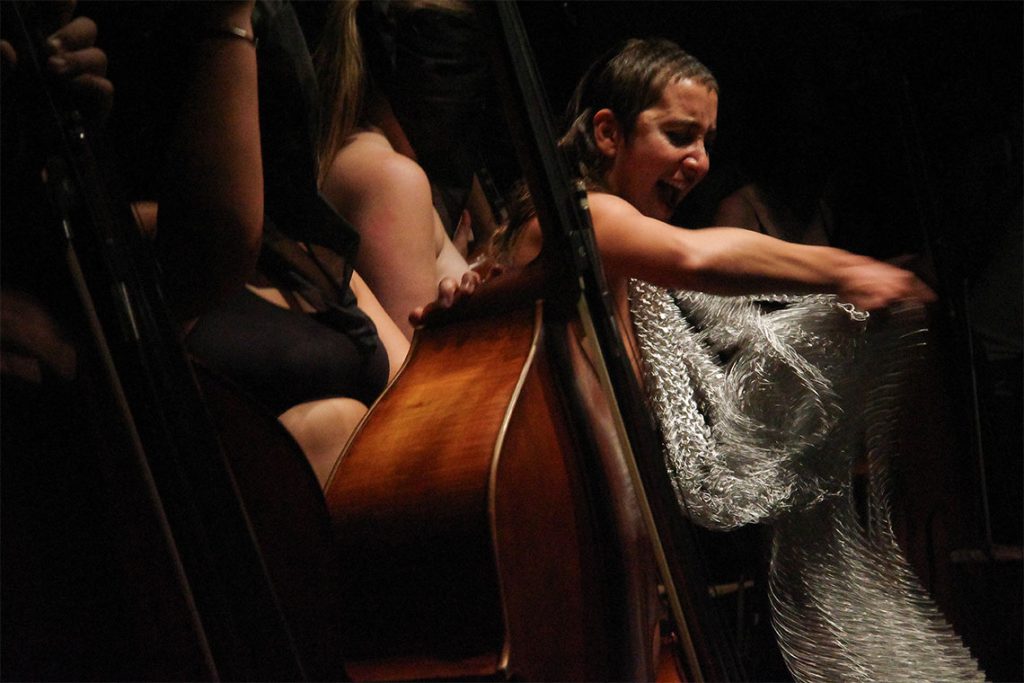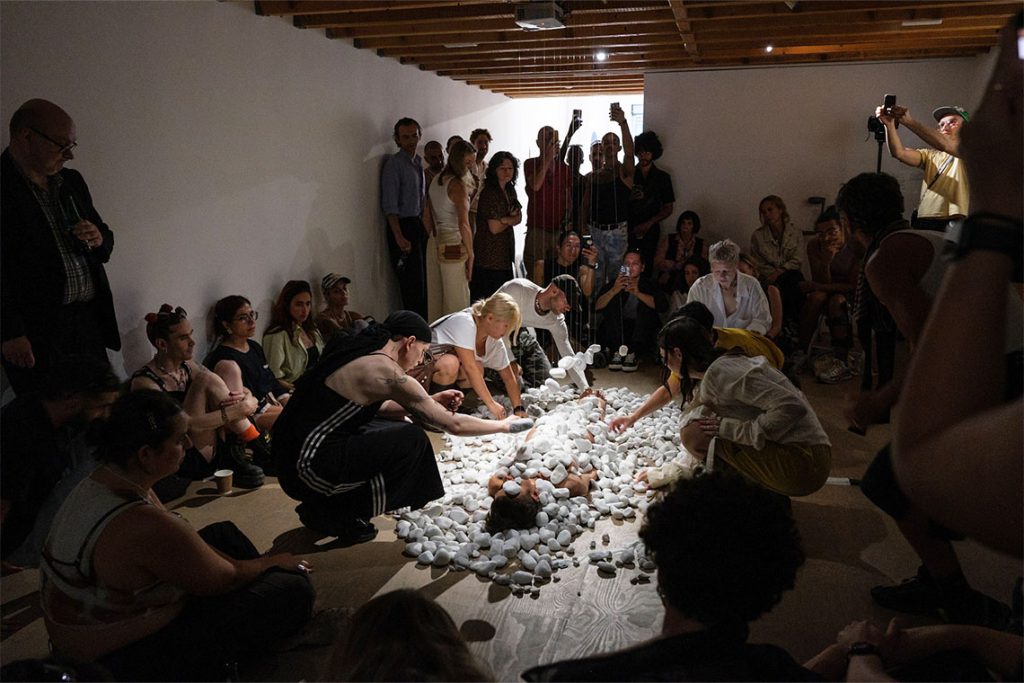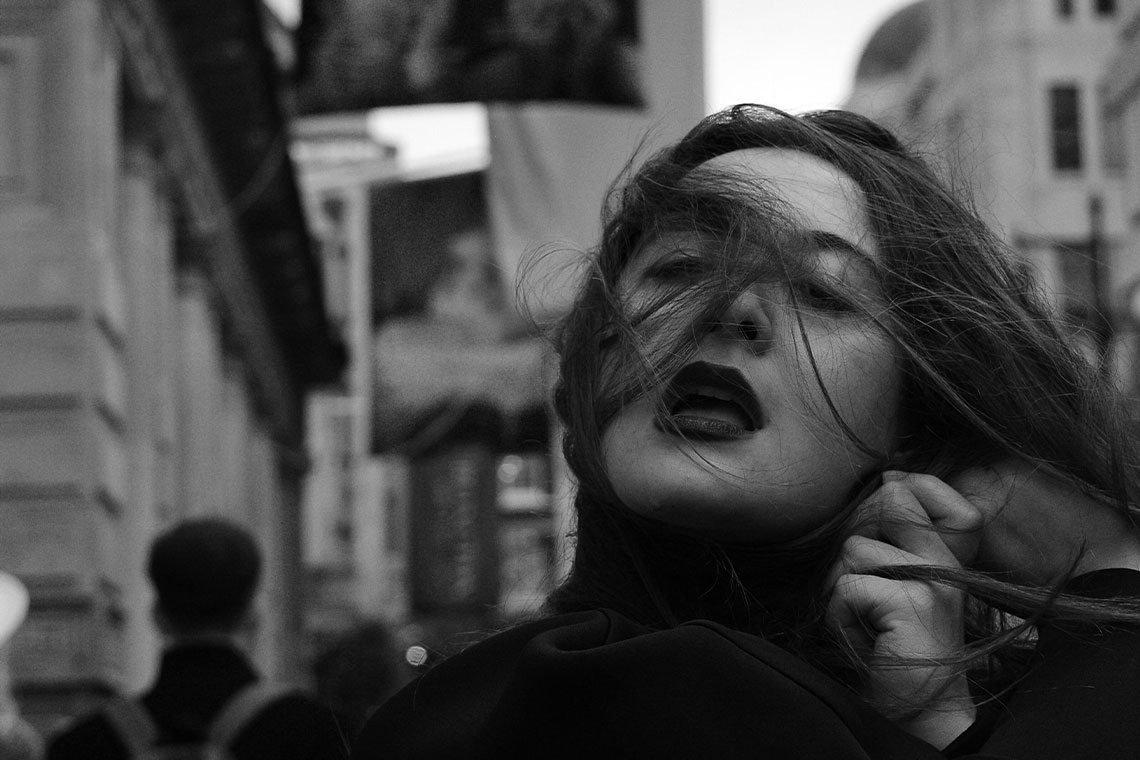The London-based Iranian-British artist and performer discusses the role of the physical body in their work and their recent performance THE CALL – MUBĀH مباح at Whitechapel Gallery.
Canvas: Movement and the body are central to your work. How do you navigate between choreography and improvisation in your creative process?
Mahsa Salali: I never formally studied dance, but I was a dancer at our Iranian family gatherings. Alongside my mum and dad, we were the main entertainers. I’ve always been drawn to free movement and improvisation. When I was studying at Trinity Laban, I worked with a lot of dancers who do contact improv and free improv, which I love. It’s the freedom of letting your body move in any direction it wants, without the constraints of formal training. In a way, not being a trained dancer gives me a kind of advantage, a freedom I really value. I’m not a huge fan of strict choreography. There are parts of it I appreciate, but in my own practice pretty much all of my movement is improvised.
You often incorporate tactile materials and found objects, like chain, rocks and stones, such as in THE CALL – MUBĀH مباح (2025) and I Float Like a Rock (2024). How do these guide the narrativising and iterating of a work?
Every piece and performance I create has many layers, and the materials I choose are always closely tied to the concept. For example, in THE CALL, the use of chain comes from the Iranian Islamic ritual of chain-beating during the holy month of Muharram. When I was a kid, I desperately wanted to take part in those ceremonies, but as a girl I wasn’t allowed to. I even had one of those small ceremonial chains at home. In the performance, I Float Like a Rock, the rocks directly reference the act of punishment by stoning, which historically has connotations to femicide.
You started out by learning on the piano. How do you view the function of music in your interdisciplinary practice?
Significantly. A lot of the improvisation comes from my early training in piano and later in composition and sound art. Having this background has shaped how I think about the structure of my performance. For instance, in THE CALL, I decided to utilise seven double basses all played by women, to highlight how few there are in orchestras. But it was also an ode to one of my favourite Russian composers, Galina Ustvolskaya. She was one of the first females to study composition during the Soviet Union and her music is phenomenal. THE CALL is a durational performance on heavy themes around gender, power, vulnerability, resilience and oppression.

How do you prepare for these types of performances and how do you care for yourself or unwind afterwards?
Whatever happens in my performances is always connected to something I’m going through in my own life. The performance is as much for me as it is for the audience and I become a reflection for them. One thing that I always say is, “Everything you see in me is a reflection of you”, because a lot of the themes like gender identity, migration and the politics of human existence are struggles many people can relate to. For THE CALL, I did a few hypnotherapy sessions with my friend Michelle to help me stay aware of the mental and physical situations I would be putting myself through, and to build resilience. I also meditate regularly. In the weeks before a performance, I often do a ritual workshop of silence and fasting as it helps me prepare mentally, emotionally and physically for the intensity of the w3ork.
How do you think about audience participation or presence when designing a work?
The audience is part of the work. They are not just passive viewers. If I ever saw them only as spectators, I would become an entertainer and that’s not a dynamic that I’m interested in having in my practice. I want to break and challenge the audience’s role. In both the art and music worlds, we often underestimate audiences. They are right there with me, they want to see me succeed and pull through the performance. I want to use their energy, anxiety, excitement, even fear, and bring them on the journey with me. I’m always fascinated to hear from the audience afterwards. Sometimes people say they felt intimidated or that the work made them feel emotions they were not able to describe or have ever experienced during a performance before. I love when a piece can unlock something unexpected in someone.

Image courtesy of the artist and Mimosa House
What has been one of the most memorable reactions to a performance of yours?
I think seeing my mother cry at the end of my performance. She came to me and gave me a big hug and in that moment, it felt like we were the only two present in the room. We shared this very intimate, vulnerable moment together in front of friends and audience. That was powerful, especially coming from a culture that does not always allow women that kind of openness. For my parents to witness and understand my work is not always easy. It’s been a challenge and growth arc for all of us. I’m deeply grateful for that moment, and I’ll carry it with me forever.
Can you share something about your work on MYTO?
MYTO is a project I started with producers Andrea Obinna Pelagatti and Justin Rivera. It’s a series of multidisciplinary events, born from marginalised club culture and underground communities, which grew out of my desire to create a collective space where artists can work without the judgement or restrictions of institutions – where performance and education can exist side by side. The idea is to create a space for dialogue and growth, both for the artists and the audience. MYTO is not just another programmed event, and it’s not just a platform for emerging artists. It’s about supporting artists who haven’t had the privilege or access to a certain level of education. The audience is also at the heart of it as they are part of the journey, and what they take away from it matters deeply to me.
How would you like your art to impact others?
I see multidisciplinary art as a kind of new language we can speak with audiences. Often, we incorporate panel talks and research discussions connected to the themes we’re exploring. That’s important to me because I want people to leave with something to read, to learn from, to think about. We live in a time of quick stimulation, where it’s harder to slow down, listen and absorb. I especially want to reach younger generations who may be involved in the art world but don’t necessarily have the access or opportunity to study, offering them something meaningful to take with them. I would like to conclude with a quote from Audre Lorde: “Nothing I accept about myself can be used against me to diminish me. I am who I am, doing what I came to do, acting upon you like a drug or a chisel, to remind you of your me-ness, as I discover you in myself.”



